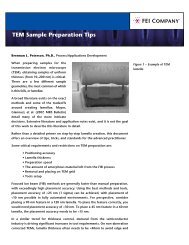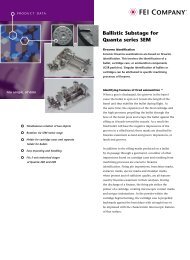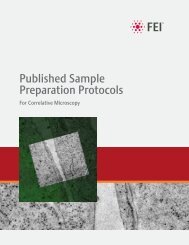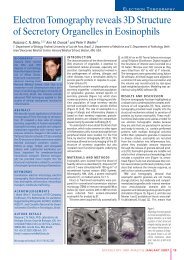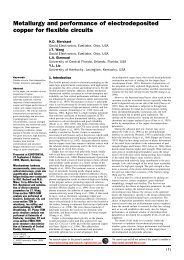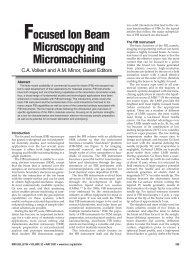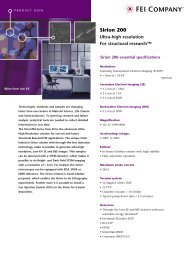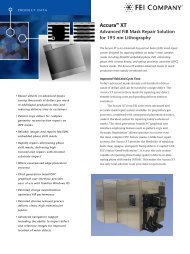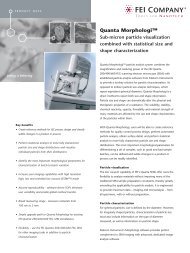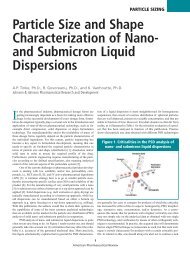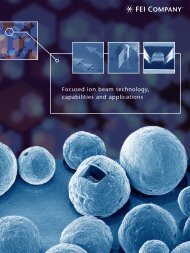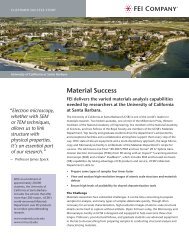Wet STEM: A newdevelopment in environmental SEM for imaging ...
Wet STEM: A newdevelopment in environmental SEM for imaging ...
Wet STEM: A newdevelopment in environmental SEM for imaging ...
Create successful ePaper yourself
Turn your PDF publications into a flip-book with our unique Google optimized e-Paper software.
well contrasted and helps <strong>for</strong> the understand<strong>in</strong>g of<br />
nanotube con<strong>for</strong>mations i.e. the positions they<br />
adopt <strong>in</strong> volume. It is specially <strong>in</strong>terest<strong>in</strong>g because<br />
this <strong>in</strong><strong>for</strong>mation should not be very different from<br />
the con<strong>for</strong>mation of nanotubes mixed <strong>in</strong> a latex<br />
suspension, which is used to synthesize polymer<br />
films with fillers <strong>in</strong>duc<strong>in</strong>g specific electrical properties.<br />
In the present wet <strong>STEM</strong> imag<strong>in</strong>g mode, signal<br />
detection conditions have been optimized, <strong>in</strong> order<br />
to obta<strong>in</strong> strong contrasts thanks to annular darkfield<br />
conditions. This is specially <strong>in</strong>terest<strong>in</strong>g <strong>for</strong><br />
polymer and biological samples, known to give<br />
lowcontrasts because of their lowatomic numbers.<br />
<strong>Wet</strong> <strong>STEM</strong> observations are per<strong>for</strong>med <strong>in</strong> a<br />
water layer that is to say <strong>in</strong> the actual environment<br />
of the samples, and <strong>in</strong> all cases, the <strong>in</strong>dividual<br />
particles are well resolved. But another experiment<br />
allowed with the present <strong>STEM</strong> device is the<br />
use of E<strong>SEM</strong> ability <strong>for</strong> dynamic imag<strong>in</strong>g. A<br />
synthetic latex has been observed dur<strong>in</strong>g <strong>in</strong> situ<br />
water evaporation. The <strong>STEM</strong> image presented on<br />
Fig. 6 shows a pile-up of particle layers, that<br />
means that multi-layers are detected <strong>in</strong> this mode.<br />
We turn nowto observe more delicate samples<br />
i.e. a liquid–liquid suspension, constituted with an<br />
aqueous phase <strong>in</strong>clud<strong>in</strong>g organic liquid spheres<br />
Fig. 6. De<strong>for</strong>med particles of homogeneous acrylic latex dur<strong>in</strong>g<br />
evaporation by heat<strong>in</strong>g: on the right, a monolayer, and on the<br />
left, a pile-up of particles layers. The large circle is a hole <strong>in</strong> the<br />
carbon layer of the TEM grid. Scale bar length: 500 nm.<br />
ARTICLE IN PRESS<br />
A. Bogner et al. / Ultramicroscopy 104 (2005) 290–301 295<br />
stabilized by a surfactant. These samples are made<br />
from m<strong>in</strong>i-emulsion polymerization technique,<br />
which can be employed to synthesize high solid<br />
content latices. Dur<strong>in</strong>g polymerization, float<strong>in</strong>g<br />
objects <strong>in</strong>cluded <strong>in</strong>to water are evolv<strong>in</strong>g from<br />
monomer droplets to solid polymer particles.<br />
Us<strong>in</strong>g the present wet <strong>STEM</strong> imag<strong>in</strong>g system,<br />
two m<strong>in</strong>i-emulsions have been characterized,<br />
correspond<strong>in</strong>g to two different stages of the<br />
polymerization process. Fig. 7 presents wet <strong>STEM</strong>:<br />
a m<strong>in</strong>i-emulsion of styrene <strong>in</strong> water (Fig. 7a), and<br />
an hybrid m<strong>in</strong>i-emulsion of polystyrene–styrene <strong>in</strong><br />
water (Fig. 7b). With the help of classical image<br />
analysis (SIS software), we found that monomer<br />
droplets sizes range from 150 to 400 nm and are<br />
homogeneously distributed. On the same figure, it<br />
Fig. 7. <strong>Wet</strong> <strong>STEM</strong> images at 30 kV <strong>in</strong> annular dark-field<br />
conditions of aqueous m<strong>in</strong>i-emulsions of (a) styrene <strong>in</strong> water,<br />
(b) polystyrene–styrene <strong>in</strong> water. Larger circles of several mm<br />
diameter are holes <strong>in</strong> the carbon layer of the TEM grid. Scale<br />
bar length: 1 mm.



